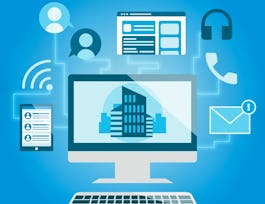The workplace is more diverse than ever before. As the world population grows and our connectivity increases, it is common to work alongside colleagues from different generations, life experiences, cultures, genders, orientations, and religions. The increased diversity coupled with the shift toward remote and hybrid work environments means it's more critical than ever to develop appropriate communication strategies and practices. This course will teach you to identify and adapt your own communication style to not only increase team productivity, but also build bridges with colleagues from all backgrounds.



Communication in the 21st Century Workplace
This course is part of Career Success Specialization

Instructor: Diane Spiegel
Sponsored by University of Michigan
131,884 already enrolled
(3,758 reviews)
What you'll learn
Differentiate between the five working generations and their communication preferences
Identify the communication benefits of different work environments, such as in-person, virtual, or hybrid
Discuss effective techniques for communicating with a diverse workforce
Implement a flexing communication strategy to better communicate with one’s workplace team
Details to know

Add to your LinkedIn profile
4 assignments
See how employees at top companies are mastering in-demand skills

Build your subject-matter expertise
- Learn new concepts from industry experts
- Gain a foundational understanding of a subject or tool
- Develop job-relevant skills with hands-on projects
- Earn a shareable career certificate


Earn a career certificate
Add this credential to your LinkedIn profile, resume, or CV
Share it on social media and in your performance review

There are 4 modules in this course
Welcome to Communication in the 21st Century Workplace! Communication in the 21st century is compounded by many changes: an increase in the world population, an increase in connectivity through technology, and advances in science and medicine. A strategy to become a more effective communicator in this changing world is to first understand where your communication style and preferences reside and how you “show up” in the workplace. This first module will focus on how you gain your energy, how you take in information, how you make decisions, and how you prefer the pace of your life. Through our activity, we will reflect on the MBTI assessment and strengths of individual styles. In our knowledge check, we will define what the four categories of MBTI are as well as identify methods to increase effective communication.
What's included
1 video9 readings1 assignment1 discussion prompt
Many factors affect 21st century workplace communication, including technological advances, the increase of remote/hybrid work options, as well as an increasingly multiethnic and multigenerational workforce. In this module, we’ll explore each of these communication change drivers and focus our discussion on how changing demographics affect workplace communication. In our knowledge check, we will differentiate between the five working generations and select the communication benefits of different work environments.
What's included
1 video6 readings1 assignment1 discussion prompt
Landing your message with clarity and impact is a hallmark of effective communication. When we tailor our messages to accommodate others' styles, to meet others where they reside, it creates more effective communication that doesn't require clarification. Flexing your style also supports our ability to collaborate. In this module, we will use our discussion to implement a flexing communication strategy to better communicate with one’s workplace team. In our knowledge check, we will recognize the benefits of flexing communication and recall strategies to improve communication.
What's included
1 video9 readings1 assignment1 discussion prompt
The A.B.I.D.E. model was created to support effective communication and as a reminder of the elements needed for clear, flexible communication and collaboration in the 21st century. The five behaviors overviewed in this module will provide ongoing support and guidance in your workplace communication. In this module's discussion, we will consider which A.B.I.D.E. element could improve communication on your current team. In our final knowledge check, we will name each element of A.B.I.D.E. and articulate how the A.B.I.D.E. model can improve communication.
What's included
1 video8 readings1 assignment1 discussion prompt
Instructor

Offered by
Why people choose Coursera for their career




Learner reviews
3,758 reviews
- 5 stars
69.26%
- 4 stars
20.35%
- 3 stars
6.57%
- 2 stars
2.20%
- 1 star
1.59%
Showing 3 of 3758
Reviewed on Oct 9, 2015
Good course. It will help both managers as well as direct reports to find a common interface for better communication, and more efficient business relationships.
Reviewed on Dec 1, 2020
I learned new strategies to effectively communicate with peers, direct reports, and executives. This same strategy I can also use in communicating with other people besides the people you work with.
Reviewed on Jan 31, 2016
The content of the course was good. Lectures were effective. I specially liked the last statement after every lecture "where ever you may be have a great time"
Recommended if you're interested in Business

Coursera Instructor Network

University of Colorado Boulder

University of California, Irvine

Johns Hopkins University

Open new doors with Coursera Plus
Unlimited access to 10,000+ world-class courses, hands-on projects, and job-ready certificate programs - all included in your subscription
Advance your career with an online degree
Earn a degree from world-class universities - 100% online
Join over 3,400 global companies that choose Coursera for Business
Upskill your employees to excel in the digital economy


